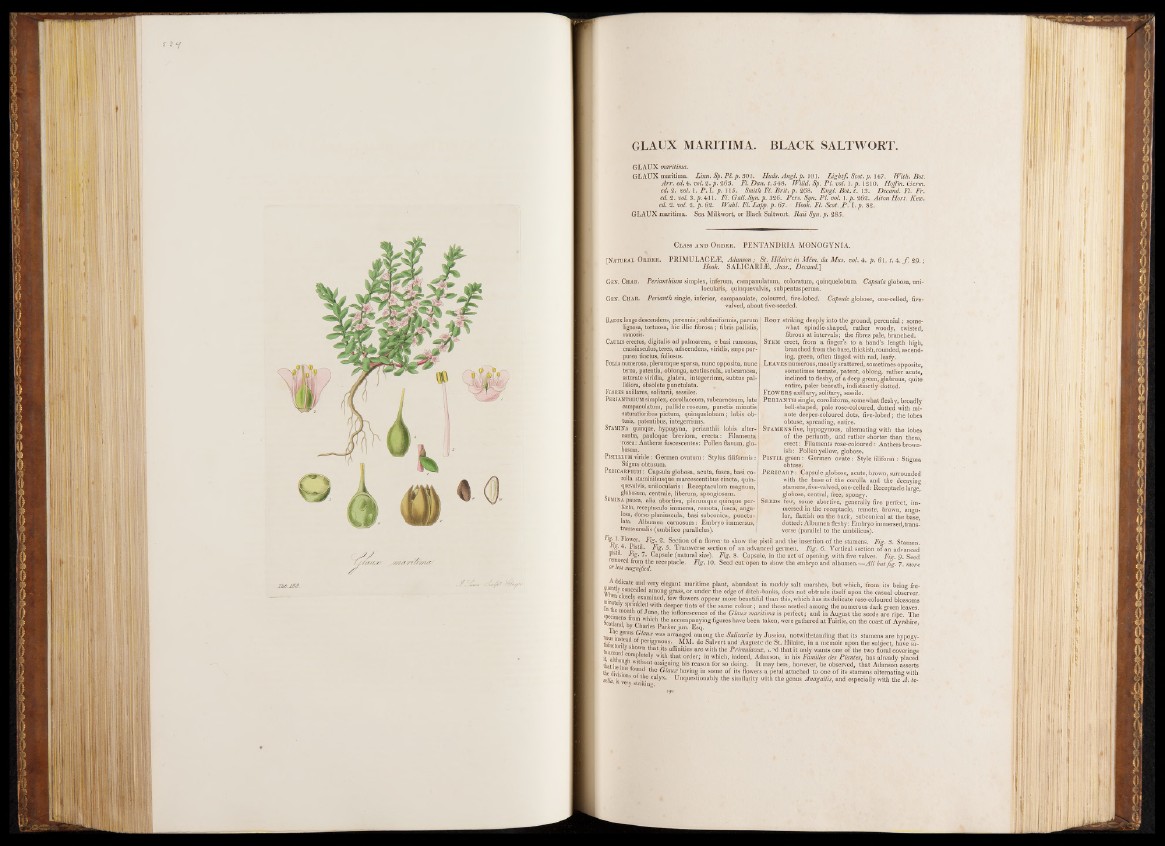
GLAUX MARITIMA. BLACK SALTWORT.
GLAUX maritima.
GLAUX maritima. Linn. Sp. PI.p. SOL Huds.Angl.p. 101. Light/. Scot.p. 147. With. Bot.
Arr. ed.ê. vol. 2 . p. 263. Fl. Dan. t. 548. fvilld. Sp. PI. ml. \.p . 1210. Hoffm. Germ,
ed. 2. vol. 1. P . I. p . 115. Smith Fl. Brit. p. 268. Engl. Bot. t. 13. Decand. Fl. Fr.
ed.2. vol. 3 .p. 411. Fl. Gall.Syn.p. 326. Pers. Syn. P i. vol. l.p . 262. AitonHort. Kew.
ed. 2. vol. 2. p . 62. Wahl. Fl. Lapp. p. 67. Hook. Fl. Scot. p . I. p. 82.
GLAUX maritima. Sea Milkwort, or Black Saltwort. Raii Syn. p. 285.
Class a nd O rd e r . PENTANDRIA MONOGYNIA.
[Natural Ord er. PRIMULACEÆ, Adanson ; St. Hilaire in Mèm. du Mus. vol. 4. ». 61. G 4. f . 29. :
Hook. SALICARIÆ, Juss., Decand.']
Gen. Chah. Perianthium simplex, inferum, campanulatum, coloratura, quinquelobum. Capsula globosa, uni-
locularis, quinquevalyis, subpentasperma.
Gen. Char. Perianth single, inferior, campanulate, coloured, five-lobed. Capsule globose, one-celled, five-
valved, about five-seeded.
Radix longedescendens, perennis; subfusiformis, parum I Root striking deeply into the ground, perennial; somei:
cu_;. what spindle-shaped, rather woody, twisted,
fibrous a t intervals; the fibres pale, branched.
Stem erect, from a finger’s to a hand’s length high,
branched from the base, thickish, rounded, ascending,
green, often tinged with red, leafy.
L eaves numerous, mostly scattered, sometimes opposite,
sometimes temate, patent, oblong, rather acute,
inclined to fleshy, of a deep green, glabrous, quite
entire, paler beneath, indistinctly dotted.
Flowers axillary, solitary, sessile.
P e r ia n th si
sa, tortuosa, hie illic fibrosa; fibris pallidis,
ramosis.
Caulis erectus, digitalis ad palmarem, e basi ramosus,
crassiusculus, teres, adscendens, viridis, saepe pur-
pureo tinctus, foliosus.
Folia numerosa, plerumque sparsa, nunc opposita, nunc
terna, patentia, oblonga, acutiuscula, subcarnosa,
saturate viridia, glabra, integerrima, subtus pal-
lidiora, obsolete punctulata.
Flores axillares, solitarii, sessiles.
Perianthium simplex, corollaceum, subcarnosum, late
campanulatum, pallide roseum, punctis minutis
saturatioribus pictum, quinquelobum; lobis ob-
tusis, patentibus, integerrimis.
Stamina quinque, hypogyna, perianthii lobis alter-
nantia, pauloque breviora, erecta: Filamenta
‘rosea: Anther® fuscescentes: Pollen flavum, glo-
bosum.
Pistillum viride: Germen ovatum: Stylus filiformis: I
Stigma obtusum.
Pericarpium : Capsula globosa, acuta, fusca, basi corolla
staminibusque marcescentibus cincta, quin-
quevalvis, unilocularis: Receptaculum magnum,
globosum, centrale, liberum, spongiosum.
Semina pauca, alia abortiva, plerumque quinque perfecta,
receptaculo immersa, remota, fusca, angu-
losa, dorso planiuscula, basi subconica, punctulata.
Albumen carnosum : Embryo immersus,
transversalis (umbilico parallelus).
igle, corolliform, somewhat fleshy, broadly
bell-shaped, pale rose-coloured, dotted with minute
deeper-coloured dots, five-lobed; the lobes
obtuse, spreading, entire.
Stamens five, hypogynous, alternating with the lobes
of the perianth, and rather shorter than them,
erect: Filaments rose-coloured: Anthers brownish
: Pollen yellow* globose.
Pist il green : Germen ovate: Style filiform : Stigma
obtuse.
P e r ica r p : Capsule globose, acute, brown, surrounded
with the base o f the corolla and the decaying
stamens, five-valved, one-celled: Receptacle large,
globose, central, free, spongy.
Seeds few, some abortive, generally five perfect, immersed
in the receptacle, remote, brown, angular,
flatfish on the back, subconical at the base,
dotted: Albumen fleshy: Embryo immersed,transverse
(parallel to the umbilicus).
Flower. Fig. 2. Section of a flower to show the pistil and the insertion of the stamens. Fig. 3. Stamen.
a sfjja £jstil- Fig. 5. Transverse section of an advanced germen. Fig. 6. Vertical section of an advanced
PIS I ‘ %•; 7. Capsule (natural size). Fig. 8. Capsule, in the act of opening, with five valves. Fig. 9. Seed
removed from the receptacle. Fig. 10. Seed cut open to show the embryo and albumen.— All but fig. 7 more
or less magnified.
oiip ,fe iCate iPff very e*e§ant maritime plant, abundant in muddy salt marshes, but which, from its being fre-
Whe ^.con, e<^ among grass, or under the edge of ditch-banks, does not obtrude itself upon the casual observer,
mininf °Se • .e.xam*?e^> Few flowers appear more beautiful than this, which has its delicate rose-coloured blossoms
I e y sPr'nkled with deeper tints of the same colour; and these nestled among the numerous dark green leaves.
specimp10 f ^u-ne’ t*ie inflorescence o f the Glaux maritima is perfect; and in August the seeds are ripe. The
Smtioe?s.teo™whlch the accompanying figures have been taken, were gathered at Fairlie, on the coast of Ayrshire.
Scotland, by Charles Parker jun. Esq. .
nous inif”!!3 * was arranged among the Salicariee by Jussieu, notwithstanding that its stamens are hypogy-
tisfactorila k Pengynous. MM. de Sal vert and Auguste de St. Hilaire, in a memoir upon the subject, have safe
Sh°?'n ^ at !ts affinides are with the Primulacea, u^d that it only wants one of the two floral coverings
it» althoim|°m te ^ "‘f*1 ®rc*er> *n which, indeed, Adanson, in his Families des Plantes, has already placed
that he has fwl , u* asa!Sning his reason for so doing. It may here, however, be observed, that Adanson asserts
the division T ! , having in some of its flowers a petal attached to one of its stamens alternating with
nella, is ve,.S °[ , y cav x* Unquestionably the similarity with the genus Anagallis, and especially with the A. te